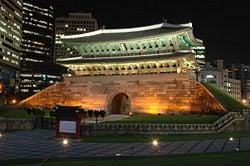Difference between revisions of "Namdaemun (gate)" - New World Encyclopedia
Dan Davies (talk | contribs) |
Dan Davies (talk | contribs) m |
||
| Line 1: | Line 1: | ||
{{claimed}} | {{claimed}} | ||
{{koreanname|image=[[Image:Seoul Namdaemun gate at night.JPG|250px|Namdaemun]] |hangul=남대문 (숭례문)|hanja= {{linktext|南|大|門}} (崇禮門)|rr=Namdaemun (Sungnyemun)|mr=Namdaemun (Sungnyemun)}} | {{koreanname|image=[[Image:Seoul Namdaemun gate at night.JPG|250px|Namdaemun]] |hangul=남대문 (숭례문)|hanja= {{linktext|南|大|門}} (崇禮門)|rr=Namdaemun (Sungnyemun)|mr=Namdaemun (Sungnyemun)}} | ||
| − | '''Namdaemun''' is located in the heart of [[Seoul]] and is an area with a mix of old and new. The landmark is officially called '''Sungnyemun''' (숭례문 Hanja | + | '''Namdaemun''' is located in the heart of [[Seoul]] and is an area with a mix of old and new. The landmark is officially called '''Sungnyemun''' (숭례문 Hanja), but it is not widely used. It is the historic city gate, used to protect the city from Amur Tigers, which have long been gone from the area. Namdaemun, literally "the southern gate," because it was the southern gate of the original walls surrounding Seoul during the [[Joseon Dynasty]]. Currently, Namdaemun serves as a gateway to Namdaemun market, a traditional twenty-four hour market that has been operating for centuries. The area is also home to several shopping malls. |
| − | Namdaemun is currently the oldest wood-built structure remaining in Seoul. The construction of this gate began in | + | Namdaemun is currently the oldest wood-built structure remaining in Seoul. The construction of this gate began in 1395 during the fourth year of the reign of [[King Taejo of Joseon]] and was finished in 1398. The remaining structure went through renovation during the reign of King [[King Sejong the Great of Joseon|Sejong]] (1447) and the tenth year of the reign of King [[King Seongjong of Joseon|Seongjong]] (1479). |
| − | In the early part of the 20th century, the city walls that surrounded Seoul were demolished by the Japanese Government, allegedly to ease the flow of traffic in the area. The gate is located halfway between | + | In the early part of the 20th century, the city walls that surrounded Seoul were demolished by the Japanese Government, allegedly to ease the flow of traffic in the area. The gate is located halfway between Seoul Station and Seoul City Plaza. |
| − | Namdaemun was damaged during the [[Korean War]] and was given its last major repair in | + | Namdaemun was damaged during the [[Korean War]] and was given its last major repair in 1962, when it was given the status of "[[National treasures of Korea|National Treasure]] No.1" on December 20, 1962. |
| − | It's located in | + | It's located in Jung-gu, Seoul, Namdaemun St 4-Ga 29. |
| + | |||
| + | == References == | ||
| + | |||
| + | == External Links == | ||
== See also == | == See also == | ||
| − | [[Category:Philosophy and religion]] | + | [[Category:Korean Philosophy and religion]] |
| − | [[Category:History and biography]] | + | [[Category:Korean History and biography]] |
[[Category:Korean culture]] | [[Category:Korean culture]] | ||
{{credit|115239168}} | {{credit|115239168}} | ||
Revision as of 20:45, 14 May 2007
| Namdaemun (gate) | ||||||||
|---|---|---|---|---|---|---|---|---|
 | ||||||||
| Korean name | ||||||||
|
Namdaemun is located in the heart of Seoul and is an area with a mix of old and new. The landmark is officially called Sungnyemun (숭례문 Hanja), but it is not widely used. It is the historic city gate, used to protect the city from Amur Tigers, which have long been gone from the area. Namdaemun, literally "the southern gate," because it was the southern gate of the original walls surrounding Seoul during the Joseon Dynasty. Currently, Namdaemun serves as a gateway to Namdaemun market, a traditional twenty-four hour market that has been operating for centuries. The area is also home to several shopping malls.
Namdaemun is currently the oldest wood-built structure remaining in Seoul. The construction of this gate began in 1395 during the fourth year of the reign of King Taejo of Joseon and was finished in 1398. The remaining structure went through renovation during the reign of King Sejong (1447) and the tenth year of the reign of King Seongjong (1479).
In the early part of the 20th century, the city walls that surrounded Seoul were demolished by the Japanese Government, allegedly to ease the flow of traffic in the area. The gate is located halfway between Seoul Station and Seoul City Plaza.
Namdaemun was damaged during the Korean War and was given its last major repair in 1962, when it was given the status of "National Treasure No.1" on December 20, 1962.
It's located in Jung-gu, Seoul, Namdaemun St 4-Ga 29.
ReferencesISBN links support NWE through referral fees
External Links
See also
Credits
New World Encyclopedia writers and editors rewrote and completed the Wikipedia article in accordance with New World Encyclopedia standards. This article abides by terms of the Creative Commons CC-by-sa 3.0 License (CC-by-sa), which may be used and disseminated with proper attribution. Credit is due under the terms of this license that can reference both the New World Encyclopedia contributors and the selfless volunteer contributors of the Wikimedia Foundation. To cite this article click here for a list of acceptable citing formats.The history of earlier contributions by wikipedians is accessible to researchers here:
The history of this article since it was imported to New World Encyclopedia:
Note: Some restrictions may apply to use of individual images which are separately licensed.